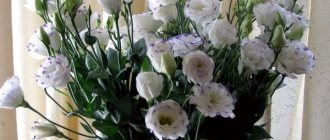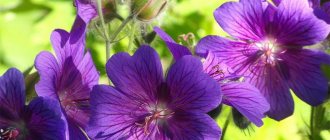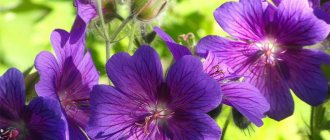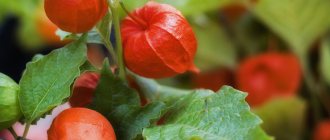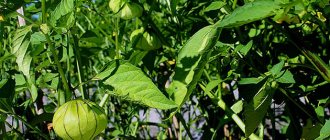Author: Elena N. https://floristics.info/ru/index.php?option=com_contact&view=contact&id=19 Category: Garden plants Published: January 28, 2019Last edits: November 13, 2020
- When to plant in the ground
- Growing conditions
- How and when to collect seeds
- Rudbeckia hirta
plant (lat. Rudbeckia) belongs to the genus of herbaceous annuals, biennials and perennials of the Asteraceae family, which includes about forty species. In nature, rudbeckia flowers are distributed mainly in the prairies of North America; in culture they are grown mostly in Europe and Africa. The first settlers to North America called rudbeckia “black-eyed Susan” because of the dark center of the inflorescence, but Europeans thought that “sunhat” was a better name for the plant. The scientific name was given to Rudbeckia by Carl Linnaeus in honor of the Swedish botanists, the father and son Rudbecks, the younger of whom was Linnaeus's friend and teacher, as well as the great-great-great-grandfather of Alfred Nobel, and was famous for his discovery of the human lymphatic system in 1653.
Planting and caring for rudbeckia
- Planting: sowing seeds in the ground - in the middle or at the end of June, sowing seeds for seedlings - at the end of March or early April, planting seedlings in the ground - at the end of May.
- Flowering: from mid-summer to frost.
- Lighting: bright sunlight.
- Soil: cultivated, fertile, drained.
- Watering: morning or evening, regular, in hot weather - frequent.
- Garter: tall forms require support.
- Feeding: in early spring, apply full mineral fertilizer, and after two weeks, repeat feeding.
- Reproduction: seed and division of the bush.
- Pests: leaf nematodes.
- Diseases: powdery mildew.
Read more about growing rudbeckia below.
Sunny flowers
Rudbeckia is rightfully considered a favorite of gardeners for its decorative value, ease of cultivation and long flowering period.
Sunny inflorescences of bright, rich and varied shades from golden to brown-black fit into the summer and even more into the autumn palette of the garden. Blooming in mid-summer, they decorate flower beds almost until frost.
In landscape design, rudbeckia is appropriate everywhere - near a fence, at home, or growing along a garden path. Tall varieties will look good in the background, in a composition with shorter plantings.
After being named plant of the year by the National Garden Bureau in 2008, rudbeckia became super popular. This was facilitated by both the diversity of species and its versatility and unpretentiousness.
Botanical description
The rudbeckia flower has simple or branched, rigidly pubescent stems, reaching a height of half a meter to 200 cm, although some wild species grow up to three meters. The leaves of rudbeckia are entire, pinnately dissected or pinnately divided, oval or ovoid, from five to twenty centimeters long, in the lower part of the stem on long petioles, in the upper part - sessile. Inflorescences-baskets up to 15 cm in diameter consist of marginal sterile reed flowers of different shades of yellow and middle bisexual tubular flowers, painted in various colors - from yellow to brown or purple-black.
The rudbeckia fruit is an oblong achene, sometimes with a small crown. Shiny, small, dark gray rudbeckia seeds remain viable for 2-3 years.
Popular varieties of hybrid rudbeckia (Rudbeckia hybrida)
Terry geranium - the most popular varieties
Hybrid plants combine the best qualities of the main types of rudbeckia - shiny, dissected and glossy. The bright appearance is combined with good resistance to various weather conditions.
Gloriosa Daisy
This plant can be either annual or perennial. The flowers have a wide color palette - from the usual yellow-orange to brown, cappuccino or cream. Reed flowers can have a double color - darker at the base and lighter closer to the edge. The border between differently colored areas is clearly visible. This makes Gloriosa Daisy one of the most beautiful varieties of rudbeckia.
Gloriosa Daisy
Double Daisy
This type of plant is distinguished by a large number of reed flowers. It cannot boast of such a wide palette as the previous hybrid, but it pleases the eye with large inflorescences. It branches abundantly and produces large leaves.
Growing rudbeckia from seeds
How to sow seeds
All species and varieties of rudbeckia, except double varieties, reproduce generatively, and only perennial species can also be propagated by dividing the rhizome. If you don't want to bother with seedlings, you can sow the seeds directly into the ground. They do this in the middle or end of June: sow the seeds on prepared beds at a distance of about 15 cm from one another and sprinkle a thin layer of earth on top, then sprinkle the crops generously with water.
- Daffodils: planting in open ground in autumn
By autumn, small rosettes of leaves will appear in the garden bed, which next year will develop into lush bushes and bloom before the rudbeckias planted in the spring. Rudbeckia in the garden also reproduces by self-sowing, and if you do not fight this phenomenon, but simply thin out the seedlings that appear from under the ground in the spring, then you don’t have to resort to seed propagation, relying on the wise nature.
Seedling care
Propagation of annual and perennial rudbeckia by seedlings begins in late March or early April by sowing the seeds in seedling boxes, sprinkling them with a thin layer of soil and lightly sprinkling the sowing with water from a sprayer. Under the film and at a temperature of 20-22 ºC, seedlings appear in one to two weeks. All this time, you need to moisten the soil in the boxes as necessary, remove condensation from the film and ventilate the crops.
When two pairs of leaves appear, the seedlings are planted more spaciously so that they do not interfere with each other’s growth, and after they have become comfortable, they begin to harden them, taking them out to the balcony or terrace every day for several hours.
Planting seedlings in a flower bed
Planting seedlings in a flowerbed must not only satisfy design ideas, but also meet certain agrotechnical criteria, which will be discussed below:
- Planting is done in late May and early June, when the likelihood of reverse frosts is minimal.
- For planting rudbeckia, use sunny or partially shaded areas.
- It is necessary to add compost to the soil over the entire area where young rudbeckia is planted, followed by digging. This should be done around the same time when the seedling hardening procedure begins.
- Plants are planted in individual holes, the distance between which should be at least 40-50 cm. For tall varieties, this distance increases to 80-100 cm.
If these requirements are met, the plants will receive enough nutrients to grow and will not compete with each other.
Planting rudbeckia
When to plant in the ground
Rudbeckia is planted in open ground at the end of May, when the threat of night frosts has passed. Select a sunny area with fertile, permeable, cultivated soil for rudbeckia. You need to add sand to clay soil before digging, but it is advisable to enrich any soil with compost before planting rudbeckia. If part of the site ends up in partial shade, it’s not a big deal; rudbeckia grows well in slightly shaded areas.
How to plant
Rudbeckia is planted in open ground at a distance of 30-40 cm between specimens. If summer has already arrived in your region, rudbeckia will quickly take root, but if spring turns out to be protracted and the nights will be cool, rudbeckia planted in a flowerbed should be covered with agrospan at night until it takes root - after that the plant is not afraid of low temperatures. In one place, perennial rudbeckia grows from 3 to 5 years, so it makes sense to mulch the area after planting with an eight-centimeter layer of compost.
Reproduction of rudbeckia by dividing the bush
Perennial rudbeckia is mainly propagated by dividing the bush. It is recommended to carry out such a procedure no more than once every 5-6 years. Mature bushes produce numerous shoots, which are disposed of in this way.
It is recommended to start dividing and planting plants before their active development begins. The best period would be early spring or autumn, after flowering has completed.
Sequencing:
- A heavily overgrown bush is carefully dug around the perimeter so as not to damage the root system and removed from the ground.
- Cut the root ball into the required number of pieces using pruners or other sharp garden tools. Each division should contain several living renewal buds.
- The cut areas are dusted with charcoal or treated with brilliant green.
- Plants are planted in pre-dug holes. At the same time, they try to maintain an interval of 70-80 cm so that the bushes have room to grow.
Rudbeckia care
Growing conditions
Planting and caring for perennial rudbeckia does not contain any subtleties or secrets - everything is as usual: watering regularly, morning or evening, often in the hot season, after watering - loosening the soil in the area while simultaneously removing weeds. Tall species and varieties of rudbeckia need to be tied to supports.
At the beginning of the season, rudbeckia is fed with a solution consisting of one tablespoon of nitrophoska, one tablespoon of potassium sulfate and one tablespoon of Agricola-7, dissolved in ten liters of water, taking into account the consumption of 3 liters of solution per 1 m² of area. After two weeks, the same fertilizing is applied again. As the inflorescences wither, they are removed with part of the peduncle up to the top healthy leaf.
Transfer
If rudbeckia grows in one place for more than five years, it produces abundant growth that clogs the area. In this case, the rudbeckia needs to be transplanted to a new location. Dig up a bush, divide it and plant the parts in a new bed, maintaining the required distance between the bushes. It is necessary to divide and replant rudbeckia when it has not yet entered a period of active growth - in early spring or after flowering.
Rudbeckia propagation
We talked about propagating rudbeckia by seed in the chapter “Growing rudbeckia from seeds,” and the method of dividing the bush is described in the previous section. There are no other ways to propagate rudbeckia.
Pests and diseases
Of the diseases, rudbeckia is extremely rare, but still affected by powdery mildew. It looks like a loose white coating on the above-ground parts of the plant. Spraying rudbeckia with a one percent solution of colloidal sulfur or a solution of copper sulfate at the rate of 80 g per 10 liters of water will help cope with the disease.
Sometimes there are cases of oppression of rudbeckia by a leaf nematode, which is expressed by the appearance of brown spots on the leaves, their thinning and death. It is effective to use Bazamid, Nemagon and Nemaphos against nematodes in the manner specified in the instructions; diseased and damaged specimens must be removed from the area. If annual rudbeckia has been affected, burn all its plant remains in the fall, carefully dig up the area and water it with a strong solution of potassium permanganate.
Rudbeckias and leaf-eating insects - larvae and caterpillars - are harmful. However, in general, rudbeckia is a plant that is rarely exposed to diseases and pests, and if planting and caring for rudbeckia is carried out in accordance with the requirements of agricultural technology, then you are unlikely to have problems with its health.
Diseases and pests
Rudbeckia has few diseases, one of them is powdery mildew. It affects the entire bush, especially the leaf system, and the leaves look as if covered with a white coating. In this case, it is necessary to treat with colloidal sulfur, or copper sulfate.
A nematode may appear - this is a formidable pest of gardens and vegetable gardens. When affected, brown spots appear on the leaves, then living tissue dies. In this case, Nemaphos will help in the early stages of the lesion. If the entire plant is affected by the nematode, it must be uprooted and burned.
Leaf nematode
Use all medications according to instructions.
Destroy pests (caterpillars and larvae) with any insect repellent.
Rudbeckia after flowering
How and when to collect seeds
Rudbeckia blooms and produces seeds in the fall. Wait for the seeds to dry on the flower, then put on gloves and carefully collect the seeds from the center of the flower, scatter them on newspaper and dry in a dry, ventilated area.
- Valerian: cultivation, properties, collection
Perennial rudbeckia in winter
Perennial rudbeckia needs shelter for the winter, but first you need to cut off the plant debris to the very surface of the soil, and then cover the area with a thick layer of humus (5-7 cm), spruce branches or dry grass.
Rudbeckia in garden design
In the garden, you can plant rudbeckia anywhere (along the fence, on the sides of paths, near buildings), since it can decorate any corner. These sunny perennials look great in compositions and individually in a flower bed. Tall specimens are usually planted in the background of the flower garden, while short ones are planted in the front or used as borders.
Rudbeckia goes well with many varieties:
- asters;
- chrysanthemums;
- monards;
- cultivated daisies;
- echinacea;
- cereal crops.
Growing rudbeckia is not difficult, even a beginner can handle it. You can enjoy these flowers until late autumn, when most ornamental plants have already faded.
Types and varieties
All cultivated species and varieties of rudbeckia are divided into annual (also known as biennial) and perennial. The most common annual species in cultivation include:
Rudbeckia hirta
Native to North America, it is usually grown as an annual or biennial. Its stems are simple or branched, stiffly pubescent, about a meter high. The basal leaves are petiolate, entire, ovate, the stem leaves are alternate, broadly lanceolate, sessile, hairy, with large teeth. On long peduncles there are basket-shaped inflorescences up to 10 cm in diameter. Reed flowers are yellow, tubular, gray-purple, the receptacle is convex.
The most commonly used varieties in cultivation are the low-growing varieties Toto Rustic, Goldflamme - up to 35 cm in height; Marmalade, Indian Summer – up to 45 cm high; Goldstrum - up to 60 cm high with simple inflorescences about 10 cm in diameter.
Rudbeckia bicolor
An erect, bushy plant, 25 to 70 cm high, with pubescent stems and lanceolate leaves. Bright inflorescences 6-8 cm in diameter are equipped with two rows of ligulate yellow or orange flowers, sometimes with a purple-black base. Tubular flowers, located on a cylindrical receptacle up to 2 cm high, are almost black in color. Flowering of rudbeckia bicolor begins in mid-June and ends before frost.
The most famous variety is Herbstwald - rudbeckia up to half a meter high with inflorescences up to 7 cm in diameter with red-brown reed flowers and black tubular ones.
Rudbeckia amplexicaulis
It grows in height up to 80 cm. Its leaves are opposite, sessile, glabrous, oval or elongated with a sharp apex and finely toothed along the edge. Reed flowers are bright yellow, tubular, located on a receptacle rising up to 3 cm, dark brown.
Rudbeckia triloba
A lush but short-flowering plant 100-140 cm high with three-lobed lower leaves and oval dark green stem leaves. The inflorescences are small, the reed flowers are yellow, the tubular flowers are dark brown.
Of the perennial species of rudbeckia, the most commonly grown are:
Shiny rudbeckia, or radiant rudbeckia (Rudbeckia fulgida)
A perennial about 60 cm high with entire, narrow lanceolate leaves. Inflorescences up to 9 cm in diameter consist of orange reed and dark red tubular flowers. The variety of rudbeckia brilliantis "variabilis" has orange-yellow edge flowers and dark purple middle flowers. In addition to this variety, the varieties Goldshturm and Goldstar with golden reed flowers and a convex brown center are known in cultivation.
Rudbeckia laciniata
Grows up to two meters in height. Its rhizome is horizontal, highly branched, the lower leaves are pinnately divided, and the stem leaves are tripartite. Inflorescences up to 10 cm in diameter consist of 1-3 rows of bright yellow marginal flowers and light yellow tubular ones. Of the many varieties of this species, the most common is the Golden Ball rudbeckia - double or semi-double rudbeckia with inflorescences up to 10 cm in diameter, consisting of bright yellow marginal flowers and greenish tubular ones.
Western Rudbeckia (Rudbeckia occidentalis)
A very unusual species, similar to a tongueless chamomile. The variety of this species, Black Beauty, for example, is devoid of reed flowers, so it looks like a black cone surrounded by green bracts. Bush height 120-150 cm.
Giant Rudbeckia (Rudbeckia maxima)
The plant is large, one might say architectural. The leaves are green with a bluish waxy coating, the reed flowers are bright yellow, and tubular flowers of dark shades grow on a strongly prominent cone-shaped receptacle. The plant is frost-resistant and drought-resistant. Inflorescences on long peduncles stand well when cut.
Rudbeckia nitida
A two-meter bush with shiny oblong-lanceolate leaves. Inflorescences reach 12 cm in diameter. Reed flowers are yellow, tubular flowers are green. The varieties of this species, Herbstonn and Goldshirm, look impressive in the garden.
- Scilla / scylla: growing in the garden, types and varieties
Rudbeckia beautiful, or beautiful (Rudbeckia speciosa)
The height is only 50-60 cm. The leaves of plants of this species are oblong or rounded, unequally toothed along the edge. Inflorescences up to 10 cm in diameter consist of orange-yellow reed flowers with three teeth at the end of the limb and black-brown tubular flowers.
Hybrid rudbeckia (Rudbeckia hybrida)
The combined name of varieties of rudbeckia glossy, hairy and dissected, with very large inflorescences up to 19 cm in diameter, in which yellow or yellow-brown reed flowers reach a length of 14 cm, and brown tubular flowers have a purple hue.
An example would be the following varieties:
- Gloriosa Daisy - the bush grows about 120 cm, grown as both an annual and perennial plant. Inflorescences up to 16 cm in diameter, consisting of one to three rows of variegated or plain flowers of yellow or yellow-brown shades and a dark brown tubular center;
- Double Daisy is a plant of the same height with rough, highly branched stems, heavily pubescent with whole ovate leaves. Double inflorescences, reaching 17 cm in diameter, consist of variegated or plain reed and brown tubular flowers.
Content:
- Rudbeckia perennial
- Rudbeckia brillianti
- Rudbeckia dissected ('Rudbeckia Laciniata')
- Rudbeckia annual
- Rudbeckia enveloping
- Rudbeckia hairy
This plant has about 30 species in the genus, among which there are more than 400 varieties, depending on which the flowers are tall and short.
Rudbeckia or Echinacea
Everyone is well aware of the healing properties of Echinacea, but few people know that Echinacea purpurea was classified by Carl Linnaeus in the genus Rudbeckia in 1753. Indeed, rudbeckia and echinacea are native to the North American prairies of the southeastern United States, and both grow in open spaces in fertile, moist soils. However, in 1794, the German botanist Mönch placed Echinacea purpurea (until then Rudbeckia purpurea) into a separate genus.
How are these plants different? Firstly, the color of the inflorescences: Echinacea has reed flowers not in the yellow-orange-brown range, like rudbeckia, but purple or crimson. In addition, rudbeckia has soft receptacles and bracts, while echinacea has spiny, hard, subulate-pointed bracts. These features of the plant are reflected in its name - “echitnos” translated from Greek means “prickly”. The third and main difference between echinacea and rudbeckia is the presence of healing properties in it. Unfortunately, the healing properties of rudbeckia are an unsubstantiated myth.
Origin and climatic requirements
Rudbeckia is a North American native, where it still grows in the prairies, predominantly in a southeastern orientation. The flower owes this name to Carl Linnaeus, who named it in honor of a family contract of botanists from Sweden under the name Rudbekov.
The plant prefers a lot of light, large spaces and enriched, moist soil. Cultivated varieties grow in Europe and Africa as perennials and annuals. Externally, rudbeckia looks like echinacea and because of this they are often confused. But they differ from each other in a number of characteristics. In addition, echinacea is used in folk medicine, but rudbeckia is not.
What is rudbeckia
The genus Rudbeckia from the Asteraceae family consists of 40 species that originate from North America. Only a few species with different life spans were cultivated in our gardens.
Rudbeckia is found as an annual, biennial or perennial. Its large (9-15 cm in diameter) inflorescences are peculiar baskets with yellow, bright marginal reed petals. The center of the flower is usually dark in color.
Rudbeckia blooms for a long time even without pruning. The flower grows from 50 cm to 3 meters in height. Flowering begins late, from the last ten days of June. But it continues until frost.



